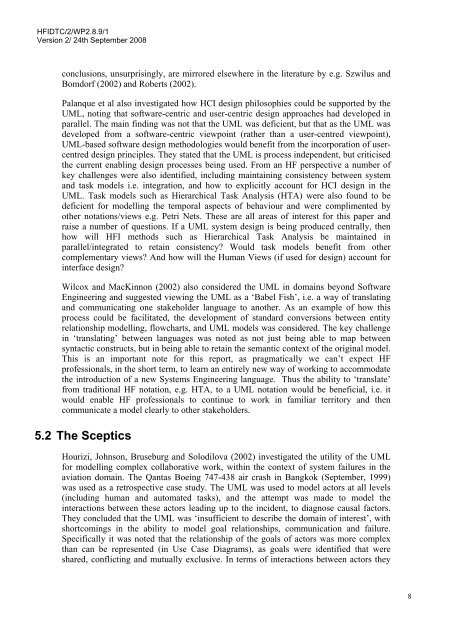Modelling Human Factors using the Systems Modelling Language
Modelling Human Factors using the Systems Modelling Language
Modelling Human Factors using the Systems Modelling Language
You also want an ePaper? Increase the reach of your titles
YUMPU automatically turns print PDFs into web optimized ePapers that Google loves.
HFIDTC/2/WP2.8.9/1Version 2/ 24th September 2008conclusions, unsurprisingly, are mirrored elsewhere in <strong>the</strong> literature by e.g. Szwilus andBomdorf (2002) and Roberts (2002).Palanque et al also investigated how HCI design philosophies could be supported by <strong>the</strong>UML, noting that software-centric and user-centric design approaches had developed inparallel. The main finding was not that <strong>the</strong> UML was deficient, but that as <strong>the</strong> UML wasdeveloped from a software-centric viewpoint (ra<strong>the</strong>r than a user-centred viewpoint),UML-based software design methodologies would benefit from <strong>the</strong> incorporation of usercentreddesign principles. They stated that <strong>the</strong> UML is process independent, but criticised<strong>the</strong> current enabling design processes being used. From an HF perspective a number ofkey challenges were also identified, including maintaining consistency between systemand task models i.e. integration, and how to explicitly account for HCI design in <strong>the</strong>UML. Task models such as Hierarchical Task Analysis (HTA) were also found to bedeficient for modelling <strong>the</strong> temporal aspects of behaviour and were complimented byo<strong>the</strong>r notations/views e.g. Petri Nets. These are all areas of interest for this paper andraise a number of questions. If a UML system design is being produced centrally, <strong>the</strong>nhow will HFI methods such as Hierarchical Task Analysis be maintained inparallel/integrated to retain consistency? Would task models benefit from o<strong>the</strong>rcomplementary views? And how will <strong>the</strong> <strong>Human</strong> Views (if used for design) account forinterface design?Wilcox and MacKinnon (2002) also considered <strong>the</strong> UML in domains beyond SoftwareEngineering and suggested viewing <strong>the</strong> UML as a ‘Babel Fish’, i.e. a way of translatingand communicating one stakeholder language to ano<strong>the</strong>r. As an example of how thisprocess could be facilitated, <strong>the</strong> development of standard conversions between entityrelationship modelling, flowcharts, and UML models was considered. The key challengein ‘translating’ between languages was noted as not just being able to map betweensyntactic constructs, but in being able to retain <strong>the</strong> semantic context of <strong>the</strong> original model.This is an important note for this report, as pragmatically we can’t expect HFprofessionals, in <strong>the</strong> short term, to learn an entirely new way of working to accommodate<strong>the</strong> introduction of a new <strong>Systems</strong> Engineering language. Thus <strong>the</strong> ability to ‘translate’from traditional HF notation, e.g. HTA, to a UML notation would be beneficial, i.e. itwould enable HF professionals to continue to work in familiar territory and <strong>the</strong>ncommunicate a model clearly to o<strong>the</strong>r stakeholders.5.2 The ScepticsHourizi, Johnson, Bruseburg and Solodilova (2002) investigated <strong>the</strong> utility of <strong>the</strong> UMLfor modelling complex collaborative work, within <strong>the</strong> context of system failures in <strong>the</strong>aviation domain. The Qantas Boeing 747-438 air crash in Bangkok (September, 1999)was used as a retrospective case study. The UML was used to model actors at all levels(including human and automated tasks), and <strong>the</strong> attempt was made to model <strong>the</strong>interactions between <strong>the</strong>se actors leading up to <strong>the</strong> incident, to diagnose causal factors.They concluded that <strong>the</strong> UML was ‘insufficient to describe <strong>the</strong> domain of interest’, withshortcomings in <strong>the</strong> ability to model goal relationships, communication and failure.Specifically it was noted that <strong>the</strong> relationship of <strong>the</strong> goals of actors was more complexthan can be represented (in Use Case Diagrams), as goals were identified that wereshared, conflicting and mutually exclusive. In terms of interactions between actors <strong>the</strong>y8
















